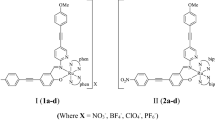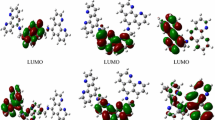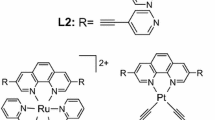Abstract
Mixed-ligand ruthenium(II) complexes of three photoactive ligands, viz., (E)-1-[2-(4-methyl-2-pyridyl)-4-pyridyl]-2-(1-naphthyl)-1-ethene (mppne), (E)-1-(9-anthryl)-2-[2-(4-methyl-2-pyridyl)-4-pyridyl]-1-ethene (mppae) and (E)-1-[2-(4-methyl-2-pyridyl)-4-pyridyl]-2-(1-pyrenyl)-1-ethene (mpppe), in which a 2,2′-bipyridyl unit is linked via an ethylinic linkage to either a naphthalene, an anthracene or a pyrene chromophore and three electroactive ligands, viz., 4-(4-pyridyl)-1,2-benzenediol (catpy), 5,6-dihydroxy-1,10-phenanthroline (catphen) and 1,2-benzenediol (cat), were synthesized in good to moderate yields. Complexes [Ru(bpy)2(mppne)]2+ (bpy is 2, 2′–bipyridyl), [Ru(bpy)2(mppae)]2+, [Ru(bpy)2(mpppe)]2+, [Ru(bpy)2(sq-py)]+, [Ru(bpy)2(sq-phen)]+ and [Ru(phen)2(bsq)]+ (phen is 1,10-phenanthroline) were fully characterized by elemental analysis, IR, 1H NMR, fast-atom bombardment or electron-impact mass, UV–vis and cyclic voltammetric methods. In the latter three complexes, the ligands catpy, catphen and cat are actually bound to the metal center as the corresponding semiquinone species, viz., 4-(4-pyridyl)-1,2-benzenedioleto(+I) (sq-py), 1,10-phenanthroline-5,6-dioleto(+I) (sq-phen) and 1,2-benzenedioleto(+I) (bsq), thus making the overall charge of the complexes formally equal to + 1 in each case. These three complexes are electron paramagnetic resonance active and exhibit an intense absorption band between 941 and 958 nm owing to metal-to-ligand charge transfer (MLCT, d Ru→π*sq) transitions. The other three ruthenium(II) complexes containing three photoactive ligands, mppne, mppae and mpppe, exhibit MLCT (d Ru→π*bpy ) bands in the 454–461-nm region and are diamagnetic. These can be characterized by the 1H NMR method. [Ru(bpy)2(mppne)]2+, [Ru(bpy)2(mppae)]2+ and [Ru(bpy)2(mpppe)]2+ exhibit redox waves corresponding to the RuIII/RuII couple along with the expected ligand (bpy and substituted bpy) based ones in their cyclic and differential pulse voltammograms (CH3CN, 0.1 M tetrabutylammonium hexafluorophosphate)—corresponding voltammograms of [Ru(bpy)2(sq-py)]+, [Ru(bpy)2(sq-phen)]+ and [Ru(phen)2(bsq)]+ are mainly characterized by waves corresponding to the quinone/semiquinone (q/sq) and semiquinone/1,2-diol (sq/cat) redox processes. The results of absorption and fluorescence titration as well as thermal denaturation studies reveal that [Ru(bpy)2(mppne)]2+ and [Ru(bpy)2(mppae)]2+ are moderate-to-strong binders of calf thymus DNA with binding constants ranging from 105 to 106 M−1. Under the identical conditions of drug and light dose, the DNA (supercoiled pBR 322) photocleavage activities of these two complexes follow the order:[Ru(bpy)2(mppne)]2+>[Ru(bpy)2(mppae)]2+, although the emission quantum yields follow the reverse order. The other ruthenium(II) complexes containing the semiquinone-based ligands are found to be nonluminescent and inefficient photocleavage agents of DNA. However, experiments shows that [Ru(bpy)2(sq)]+-based complexes oxidize the sugar unit and could be used as mild oxidants for the sugar moiety of DNA. Possible explanations for these observations are presented.






Similar content being viewed by others
References
Ji L-N, Zou X-H, Liu J-G (2001) Coord Chem Rev 216–217:513–536
Erkkila KE, Odom DT, Barton JK (1999) Chem Rev 99:2777–2795
Xiong Y, Ji L-N (1999) Coord Chem Rev 185–186:711–733
Kelly SO, Barton JK (1998) In: Sigel A, Sigel H (eds) Metal ions in biological systems, vol 39. Marcel Dekker, New York, pp 211–249
Mesmaeker AK-De, Lecomte JP, Kelly JM (1996) In: Mattay J (ed) Topics in current chemistry, vol 177. Springer, Berlin Heidelberg New York, pp 25–76
Kane-Maguire NAP, Wheeler JF (2001) Coord Chem Rev 211:145–162
Kaes C, Katz A, Hosseini MW (2000) Chem Rev 100:3553–3590
Armitage B (1998) Chem Rev 98:1171–1200
Sigman DS, Mazumder A, Perrin DM (1993) Chem Rev 93:2295–2316
DeArmond MK, Carlin CM (1981) Coord Chem Rev 36:325–355
Turro C, Bossmann SH, Jenkins Y, Barton JK, Turro NJ (1995) J Am Chem Soc 117:9026–9032
Friedman AE, Kumar CV, Turro NJ, Barton JK (1991) Nuclic Acids Res 19:2595–2602
Hartshorn RM, Barton JK (1992) J Am Chem Soc 114:5919–5925
Murphy CJ, Barton JK (1993) Methods Enzymol 226:576–580
Ambroise A, Maiya BG (1999) Inorg Chem 38:842–843
Ambroise A, Maiya BG (2000) Inorg Chem 39:4256–4263
Ambroise A, Maiya BG (2000) Inorg Chem 39:4264–4272
Sastri CV, Eswaromoorthy D, Giribabu L, Maiya BG (2003) J Inorg Biochem 94:138–145
Ghosh D, Shukla AD, Banerjee R, Das A (2002) J Chem Soc Dalton Trans 1220–1225 (and references therein)
Shukla AD, Das A (2000) Polyhedron 19:2605–2611
Shukla AD, Ganguly B, Dave PC, Samanta A, Das A (2002) Chem Commun 2648–2649
Jose AD, Shukla AD, Krishnakumar D, Ganguly B, Das A, Ramakrishna G, Ghosh HN (2005) Inorg Chem 44:2414–2425
Flowers L, Ohnishi ST, Penning TM (1997) Biochemistry 36:8640–8648
Bolton JL, Trush MA, Penning TM, Dryhurst G, Monks TJ (2000) Chem Res Toxicol 13:135–160
Schelvis JPM, Ramsey M, Sokolova O, Tavares C, Cecala C, Connell K, Wagner S, Gindt YM (2003) J Phys Chem B 107:12352–12362
Yang CH, Chen WF, Jong MC, Jong BJ, Chang JC, Waring MJ, Ma L, Sheh L (2004) J Am Chem Soc 126:8104–8105
Perrin DD, Armarego WLF, Perrin DR (eds) (1980) Purification of laboratory chemicals. Pergamon Press, New York
Juris A, Balzani V, Barigelletti F, Campagna S, Belser P, Zelewsky AV (1988) Coord Chem Rev 84:85–277
Sullivan BP, Salmon DJ, Meyer TJ (1978) Inorg Chem 17:3334–3341
Paw W, Eisenberg R (1997) Inorg Chem 36:2287–2293
Decurtins S, Felix F, Ferguson J, Güdel HU, Ludi A (1980) J Am Chem Soc 102:4102–4106
Connelly NG, Geiger WE (1996) Chem Rev 96:877–910
Reichmann ME, Rice SA, Thomas CA, Doty P (1954) J Am Chem Soc 76:3047–3053
Wolfe A, Shimer GH, Meehan T (1987) Biochemistry 26:6392–6396
Kumar CV, Asuncion EH (1993) J Am Chem Soc 115:8547–8553
McGhee JD, von Hippel PH (1974) J Mol Biol 86:469–489
Kelly JM, Tossi AB, McConnell DJ, OhUigin C (1985) Nucleic Acids Res 13:6017–6034
Marmur J, Doty P (1962) J Mol Biol 5:109–118
Bhadbhade MM, Das A, Jeffery JC, McCleverty JA, Badiola JAN, Ward MD (1995) J Chem Soc Dalton Trans 2769–2777
Ernst S, Hanel P, Jordanov J, Kaim W, Kasack V, Roth E (1989) J Am Chem Soc 111:1733–1738
Barthram AM, Cleary RL, Kowallick R, Ward MD (1998) Chem Commun 2695–2696
Haga M, Dodsworth ES, Lever ABP (1986) Inorg Chem 25:447–453
Wilson GJ, Launikonis A, Sasse WHF, Mau AW-H (1997) J Phys Chem A 101:4860–4866
Pyle AM, Rehmann JP, Meshoyrer R, Kumar CV, Turro NJ, Barton JK (1989) J Am Chem Soc 111:3051–3058
Wang AH-J (1992) Curr Opin Struct Biol 2:361–368
Wang JG (1974) J Mol Biol 89:783–801
Friedman AE, Chambron J-C, Sauvage J-P, Turro NJ, Barton JK (1990) J Am Chem Soc 112:4960–4962
Moucheron C, Mesmaeker AK-De, Choua S (1997) Inorg Chem 36:584–592
Wu J, Du F, Zhang P, Khan IA, Chen J, Liang Y (2005) J Inorg Biochem 99:1145–1154
Long EC, Barton JK (1990) Acc Chem Res 23:271–273
Thorp HH (1995) Adv Inorg Chem 43:127–177
Norden B, Lincoln P, Akerman B, Tuite E (1996) In: Sigel A, Sigel H (eds) Metal ions in biological systems, vol 33. Marcel Dekker, New York, pp 177–252
Goldstein BM, Barton JK, Berman HM (1986) Inorg Chem 25:842–847
Morgan RJ, Chatterjee S, Baker AD, Strekas TC (1991) Inorg Chem 30:2687–2692
Tysoe SA, Morgan RJ, Baker AD, Strekas TC (1993) J Phys Chem 97:1707–1711
Xu H, Zheng KC, Chen Y, Li YZ, Lin LJ, Li H, Zhang PX, Ji LN (2003) J Chem Soc Dalton Trans 2260–2268
Zhen QX, Zhang QL, Liu JG, Ye BH, Ji LN, Wang L (2000) J Inorg Biochem 78:293–298
Acknowledgements
This work was supported by the Department of Science and Technology (DST), New Delhi. T.G., A.D.S., D.A.J. and K.K. are thankful to the CSIR (New Delhi) for research fellowships. The UPE Program of the UGC (New Delhi) at the University of Hyderabad is also thanked for some of the instrumentation facilities.
Author information
Authors and Affiliations
Corresponding author
Electronic Supplementary Material
Rights and permissions
About this article
Cite this article
Ghosh, T., Maiya, B.G., Samanta, A. et al. Mixed-ligand complexes of ruthenium(II) containing new photoactive or electroactive ligands: synthesis, spectral characterization and DNA interactions. J Biol Inorg Chem 10, 496–508 (2005). https://doi.org/10.1007/s00775-005-0660-6
Received:
Accepted:
Published:
Issue Date:
DOI: https://doi.org/10.1007/s00775-005-0660-6




